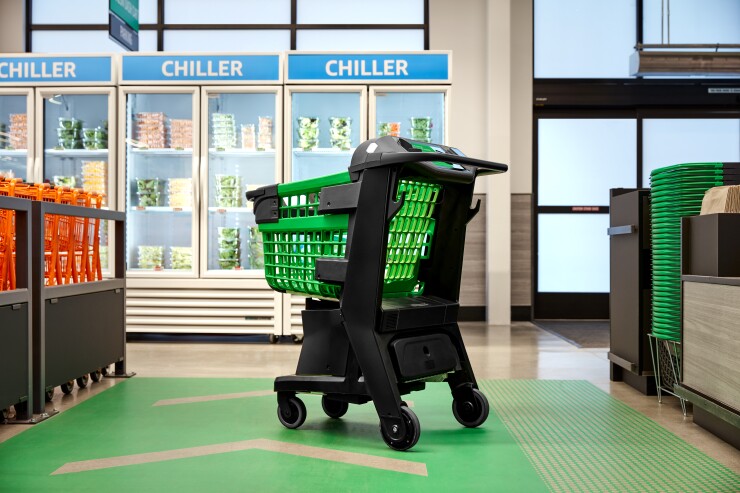A former toy store is hosting the latest of Amazon’s attempts to use its enrolled base, mobile app and automatic sensors to create an alternative to supermarket checkout lanes.
Called the Dash Cart, Amazon’s new device uses a mix of cameras and sensors to identify items placed inside it — harnessing the power of its Amazon Go convenience stores in something much more portable.
Shoppers sign in with a QR code on Amazon’s app and place items into the Dash Cart, which beeps when the product is identified. It can also flash orange to instruct the shopper to re-enter the item.
The carts have a display with Alexa shopping lists and coupon scanners that allow consumers to add discounts on the fly. Shoppers leave the store through specified Dash lanes and the receipt is sent to the shopper’s email address on file. The store will retain traditional checkout lanes.
As with all new supermarket technology, the challenge is to remove more friction than it adds. Amazon’s carts aren't perfect; there are

“If the customer needs to do more work, there needs to be an offset in value, either lower costs or a dramatic improvement in convenience/time saved,” said Thad Peterson, a senior analyst at Aite.
The first Amazon location to use the carts is a 35,000 square foot big box store in Los Angeles that was previously a Toys R Us but is now one of Amazon’s first supermarkets. By embedding automatic checkout in the cart, Amazon can take advantage of its enrolled base of Prime consumers for potential incentive marketing, data analysis and cross-promotion. Amazon did not provide comment for this story.
Dash Cart isn’t directly part of Amazon Go or Whole Foods, but resides somewhere in between. Amazon’s supermarkets are much larger than the checkout-free Amazon Go stores, which are generally less than 10,000 square feet, or the size of a typical convenience store. Whole Foods has added Pay with Amazon.
Amazon Go serves a limited inventory for small purchases, and this varies greatly from store to store. The Amazon Go store next to New York's World Trade Center has fresh coffee and a fountain soda machine with customizable flavors, as well as limited seating; the one in nearby Brookfield Place has none of these things, but instead has a selection of drug-store items such as travel-size Advil.
Size has also been a factor; Amazon's earliest Go stores reportedly had
“Amazon appears to be experimenting with a variety of different approaches to reducing friction in grocery,” Peterson said.
The supermarkets include space for online order and pickup and have most of the produce and other food that a typical supermarket would have.
In the supermarket industry, Amazon is battling Walmart, Costco and dozens of other chains, all of which are migrating away from traditional checkout lines to a mix of self-serve, online order and pickup and delivery.
Walmart has also developed new shopping cart technology, recently filing a
“The [checkout-free] system of network cameras and sensors require high capital outlays, making it more cost-effective in smaller stores,” said Raymond Pucci, director of merchant services at Mercator. Developers such as AiFi, Grabango, Standard Cognition are also building autonomous technology, which should bring the technology costs down over time, Pucci said.
If the Los Angeles test is successful, it potentially addresses the consumer comfort challenge of demonstrating a system that can work alongside — rather than replace — existing shopping habits.
Seventy-seven percent of consumers say they will try a new technology only after their friends try it or after it’s been available for a long time, according to Rachel Huber, a senior analyst for payments at Javelin Strategy & Research.
“By letting consumers observe and see the technology in addition to their normal shopping habits, it can drive curiosity while simultaneously not alienating a consumer from even entering the store as may be the case with a fully checkout-free concept such as the Go stores,” Huber said.





